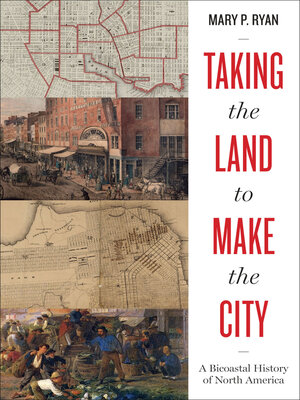Taking the Land to Make the City
ebook ∣ A Bicoastal History of North America · Lateral Exchanges: Architecture, Urban Development, and Transnational Practices
By Mary P. Ryan

Sign up to save your library
With an OverDrive account, you can save your favorite libraries for at-a-glance information about availability. Find out more about OverDrive accounts.
Find this title in Libby, the library reading app by OverDrive.



Search for a digital library with this title
Title found at these libraries:
| Library Name | Distance |
|---|---|
| Loading... |
This historical study shows how San Francisco and Baltimore were central to American expansion through the eighteenth and nineteenth centuries.
The history of the United States is often told as a movement westward, beginning at the Atlantic coast and following farmers across the continent. But early settlements and towns sprung up along the Pacific as well as the Atlantic, as Spaniards and Englishmen took Indian land and converted it into private property. In this ambitious study of historical geography and urban development, Mary P. Ryan reframes the story of American expansion.
Baltimore and San Francisco share common roots as early coastal trading centers immersed in the international circulation of goods and ideas. Ryan traces their beginnings back to the first human habitation of each area, showing how the juggernaut toward capitalism and nation-building could not commence until Europeans had taken the land for city building. She then recounts how Mexican ayuntamientos and Anglo-American city councils pioneered a prescient form of municipal sovereignty that served as both a crucible for democracy and a handmaid of capitalism.
Moving into the nineteenth century, Ryan shows how the citizens of Baltimore and San Francisco molded the shape of the modern city: the gridded downtown, rudimentary streetcar suburbs, and outlying great parks. This history culminates in the era of the Civil War when the economic engines of cities helped forge the East and the West into one nation.
The history of the United States is often told as a movement westward, beginning at the Atlantic coast and following farmers across the continent. But early settlements and towns sprung up along the Pacific as well as the Atlantic, as Spaniards and Englishmen took Indian land and converted it into private property. In this ambitious study of historical geography and urban development, Mary P. Ryan reframes the story of American expansion.
Baltimore and San Francisco share common roots as early coastal trading centers immersed in the international circulation of goods and ideas. Ryan traces their beginnings back to the first human habitation of each area, showing how the juggernaut toward capitalism and nation-building could not commence until Europeans had taken the land for city building. She then recounts how Mexican ayuntamientos and Anglo-American city councils pioneered a prescient form of municipal sovereignty that served as both a crucible for democracy and a handmaid of capitalism.
Moving into the nineteenth century, Ryan shows how the citizens of Baltimore and San Francisco molded the shape of the modern city: the gridded downtown, rudimentary streetcar suburbs, and outlying great parks. This history culminates in the era of the Civil War when the economic engines of cities helped forge the East and the West into one nation.







